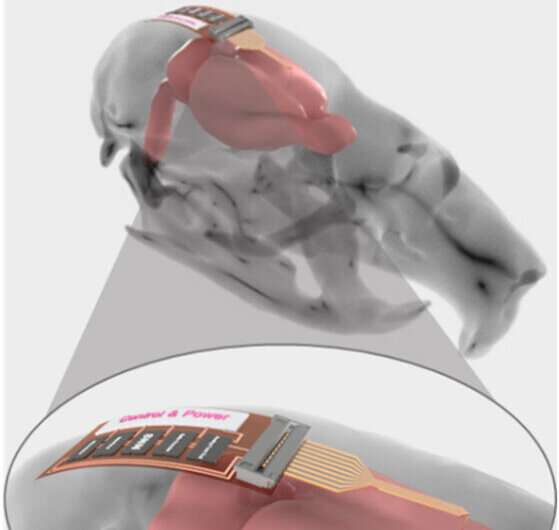This article has been reviewed according to Science X's editorial process and policies. Editors have highlighted the following attributes while ensuring the content's credibility:
fact-checked
trusted source
proofread
New materials could lead to implantable treatments for epilepsy

The prospect of a cure for a type of epilepsy could be one step closer following breakthrough research on materials that may help new types of probes be safely implanted in the brain.
Bioengineering researchers from the University of Glasgow have investigated new dissolvable coatings which could help safely guide flexible implants into brains to help regulate temporal lobe epilepsy.
The development of the material, outlined in an early-view paper in the journal Advanced NanoBiomed Research, is part of a collaboration that aims to tackle epilepsy by treating and regenerating damaged brain tissue.
The €8m Hybrid Enhanced Regenerative Medicine Systems project—HERMES—was launched in 2019. It brings together 12 partners from seven EU countries to find new ways to heal brain disorders using transplants that combine biological and artificial components.
Neural probes capable of deep brain stimulation have been used to help treat people living with Parkinson's disease and other conditions like obsessive-compulsive disorder. They are a promising future treatment for temporal lobe epilepsy, which can be resistant to drugs.
Currently, deep brain stimulation probes, which are made from silicon, often cause scarring around their implantation site because of a mismatch between the stiffness of the artificial materials and the soft tissue of the brain.
One solution could be a new generation of flexible probes made from new bendable materials which offer a better match with the softness of brain tissue. Flexible implants could also widen the possibilities of where the implants could be placed in the brain, opening up treatments for more conditions.
However, the increased flexibility of the materials can increase the risk of the probes bending or breaking when introduced into brain tissue—a key problem that needs to be solved before the HERMES team and others can use them effectively as implants.
In the paper, the Glasgow team and colleagues in Italy outline how they explored the potential of four different biological materials as coatings for future HERMES implants. The materials act as temporary stiffeners, which could allow flexible probes to reach their target in the brain without bending, before dissolving once the surgery is complete.
They examined the performance of sucrose, maltose, silk fibroin and alginate as stiffeners for a flexible probe like the one which will be used in the HERMES project.
While three of the materials had previously been tested in the lab as stiffeners in previous research, the Glasgow team were the first to explore alginate, a naturally occurring polysaccharide extracted from algae, as a stiffening material.
They coated flexible probes similar to those that will be used in future HERMES implants in samples of the materials. They tested their performance as stiffeners by examining their performance as they were inserted into blocks of agarose gel—a material with a similar consistency to real brain tissue.
The alginate-covered probes performed well, increasing the force required to buckle from 0.31 millinewtons for an uncoated probe to 28.97 millinewtons. However, the silk fibroin performed best, increasing the force required to bend the flexible probe to 75.99 millinewtons.
They also tested the material's potential biocompatibility by conducting chemical tests and measuring how long they took to dissolve in brain-like conditions. Again, the silk fibroin and alginate materials performed well, lasting longer than the other materials before dissolving, which could offer surgeons more time to perform HERMES implant operations successfully.
The silk fibroin materials were further tested in samples of lambs' brains and in rat brains to gather further data about their performance in human-like brains.
Maria Cerezo-Sanchez, from the James Watt School of Engineering, is the lead author of the article. She said, "The tests we conducted show some really promising results for creating coatings for future flexible neural probes that could help safely guide them to their targets in the brain.
"It's an exciting step forward, and we're continuing to explore the potential of these materials for use in neural implant procedures."
Professor Hadi Heidari, of the University of Glasgow's James Watt School of Engineering, is the paper's corresponding author. He said, "The work we've done here is an important pillar of the strands of research that are coming together to create the advanced neuroprostheses that HERMES is aiming to achieve.
"Some of our research partners are using the stiffeners we've developed to conduct further tests on the functionality of the probes. We're looking forward to seeing the results of those experiments as we get closer to delivering on the potential of HERMES."
More information: Maria Cerezo-Sanchez et al, Bioresorbable Insertion Aids for Brain Implantable Flexible Probes: A Comparative Study on Silk Fibroin, Alginate, and Disaccharides, Advanced NanoBiomed Research (2023). DOI: 10.1002/anbr.202200117
Provided by University of Glasgow





















